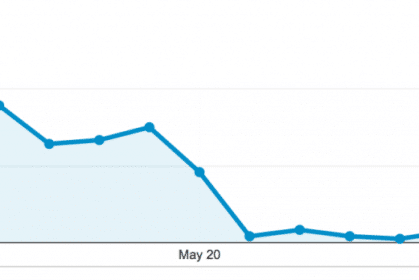

27/01/2021, SEO
How could a web designer kill your business?
I was recently contacted by a young entrepreneur I support at the Prince’s Trust. We’ll call him “Sammy” for the purpose of this article (not his real name).
Sammy was always one of my better students and had used his new-found knowledge to apply SEO to his website when it first launched in 2013. For the past seven years, his website consistently ranked at the top of Google’s organic results for all of his key search terms.
A few months ago, Sammy decided it was time to get a new website built, so he contacted an experienced web design agency. The new site was launched in November 2020.
Almost immediately, the site’s Google traffic took a deep nosedive. Search queries for which his site previously appeared at the top of Google’s first page dropped to the bottom of page two and continued to decline. It was at this point that Sammy contacted me to ask for advice.
Even without checking his site, I had a suspicion as to the likely cause.
What went wrong?
Sammy’s old website had a few key pages that were deemed important by Google. These pages attracted a large amount of search traffic and were linked to from many other authoritative sites on the web.
Google views your website as trustworthy and popular when pages on your site gain editorial links from other trustworthy websites. These “backlinks” are a key component of Google’s ranking algorithm and have been since the search engine first launched.
In the process of redesigning Sammy’s website and migrating the content to a new platform, the web designers changed the address of every page on the site. Links previously pointing to these important pages were now redirected several times before reaching their final destination. Most were now pointing to a non-existent page.
I was able to quickly diagnose this issue because I have seen the same error made on many previous occasions.
What can cause this?
- Pages are redirected to content on a different topic.
- A site is migrated from http (non-secure) to https (secure).
- A site is migrated from https://www.sitename.com to https://sitename.com (without the www.)
- A site is migrated to a new domain name.
- A URL is changed to a different folder path.
- A page is moved from a subfolder to a subdomain (or vice versa).
- A URL is changed from uppercase to lowercase text.
Search engines do not recognise pages. They work with URLs. If the URL of a page is changed in any way, Google will assume that the old page no longer exists.
How can you avoid this?
There are many tasks to consider when migrating a website. Arguably, one of the most important is to create a redirection map to permanently divert visitors and search engines from the old URL of a page to its new location. This process is neither difficult nor costly.
Why do so many web designers get this wrong?
Unfortunately, many web designers do not have even a basic knowledge of SEO, despite often claiming otherwise.
SEO is not the function of a web designer. Their job is to design the website, not to optimise it for Google.
Although some larger web agencies may have an experienced in-house SEO consultant, they are typically far beyond the budget of most SMEs.
Who is at fault?
A web designer who claims to understand SEO and yet fails to implement even basic SEO practices must accept some responsibility.
However, it is also the client’s responsibility to do their due diligence when hiring web designers. They should ensure that the designer has the necessary skills to handle a site migration or hire someone who does.
Conclusion
SEO and web design are two different skills. You wouldn’t ask your plumber to rewire your house. Likewise, you should avoid asking a web designer to manage your SEO.
I have access to the website analytics of more than 500 businesses. In almost every case, organic visitors from Google are the primary traffic source of traffic and leads to the site. Many businesses would cease to exist if they lost this vital source of traffic.
If you plan to get a new website for your business and your site is reliant on search engine traffic, make sure you engage an experienced, professional SEO. I’m afraid that I can’t personally assist you, but there are plenty of good people who would be happy to help.
Alternatively, manage the migration yourself using this handy guide.

